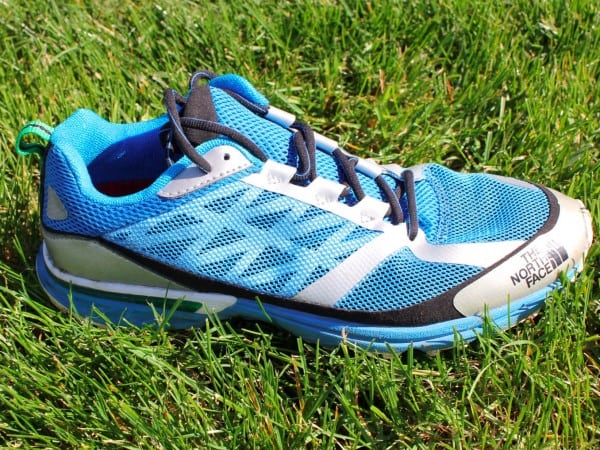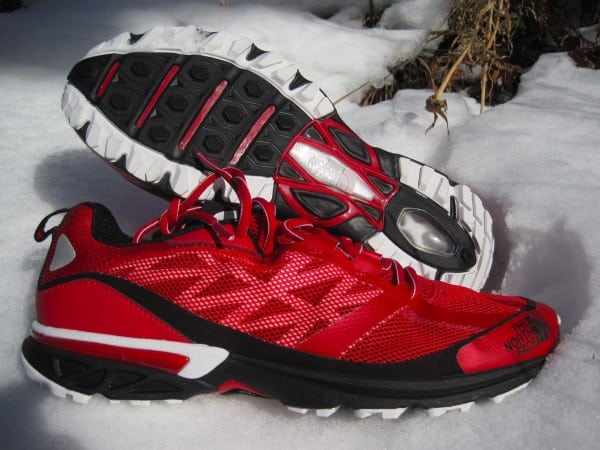Our Favorite Trail Running Shoes
Check out our Best Trail Running Shoes article to learn about our current favorite trail running shoes!
The North Face Single-Track Hayasa Review
The latest addition to The North Face’s Single-Track trail running shoe line is the Hayasa ($110) and it was developed with speed in mind. In fact, “Hayasa” means “speed” in Japanese, which is fitting as the concept for the shoe came out of TNF’s Japanese team. This race-ready trail shoe weighs in at 8.3 ounce and sits low to the ground with a 10mm heel-to-toe drop (8mm forefoot/18mm heel). While the Hayasa was designed to be an able trail racer, TNF didn’t skimp with protection or support, so this shoe could work as an everyday trainer for a good portion of trail runners.
The North Face Single-Track Hayasa Review Transcript
The Single-Track Hayasa is part of The North Face’s trail running line. This is the third trail shoe they have in that line with those being the Single-Track, the Double-Track, and now this latest version which is the Single-Track Hayasa. Hayasa is Japanese for “speed,” so they’ve really built this to be a lower profile, lighter weight shoe. This one actually comes in at 8.3 ounces in a men’s size 9 and 7.2 ounces in a women’s size 7 all with an 18mm-8mm heel-to-toe drop. So with those stats out of the way, let’s get up close and personal and see what this shoe has to offer.
Outsole
So let’s start with taking a look at our outsole. From a tread perspective we have a relatively low-profile lug pattern on these shoes. So they’re going to be good for your general purpose trail running, your fire roads, and maybe even do a nice job with that transition—maybe you’ve got a little bit of road, a long dirt road or fire road or that sort of thing and you’re not going to notice these lugs because, again, they’re relatively low profile. Of course, the downside to that in muddy and sloppy conditions this does not do as well, because you don’t have the surface area and the depth there to really add a lot of grip. But for general purposes, this is definitely going to fall in that category for trail running and also some light duty road running.
Let’s start by looking at this white part around the perimeter. These lugs are forward facing so they’re going to help with climbs, they are directional. Then in the middle part of the shoe you have some more general-purpose lugs in the center of the shoe basically where the midfoot and forefoot are going to be at. In the middle, we don’t have any lugs at all, so we skip all the way back to the back part of the heel. Again, around the perimeter of the heel you have these lugs that are going to switch direction and go to reverse facing all the way to the back which is going to help you brake going downhill.
Rockplate and Cradle
If we look up towards the front, essentially starting just behind your toes, working all the way back, we see this green. That’s going to be what’s known as a Snake Plate. In The North Face’s world, instead of having one large rock plate that extends from toe all the way to heel, you have this plate that sort of snakes in and out. The idea of that is to add flexibility so you have a protective plate without being too stiff and also save weight. One of the things I noticed from this Snake Plate was every now and then, especially when running on rocky terrain, I happened to hit some spots where that snake plate didn’t exist, and I could feel that rock poke through vs. some of the other spots. However, it wasn’t poking all the way through the shoe, because you do have traction and tread and outsole in those spots. It’s just something to keep in mind because it’s not a full plate that’s in here.
When we move back into the heel, we have this little window that gives us a view into this cage or cradle that this shoe has which we’ll talk about here in a minute. This is relatively thick in here though I do see that potentially getting a hole poked in it but in anything I was on, I didn’t seem to have any of those problems and it’s really not showing any signs of wear. I just wanted to make sure to call that out.
Midsole
So when we move to the midsole, we have a dual-density foam but for all intents and purposes, it’s single density all the way around, on the inside, to the toe, and all the way back. The only place we have a dual density of foam is in this heel cradle which is this green plastic which extends up from the back here and creates basically this dome that your foot is going to fit inside which is going to provide some stability and also some support for your foot to stay in here. So basically it’s a way of keeping your heel locked in and giving some stability to the shoe and the way that it rides without having to create any pronation control or anything like that.
This shoe is definitely on the neutral side. So this single-density foam is 18mm at the heel and 8mm at the toe for a 10mm offset. While it’s not an extremely low drop in terms of what we have now with 0mm and 4mm and 5mm, you have a shoe that rides low to the ground and has a normal-to-slightly-below-average drop of 10mm. This other foam, this white foam is again just around the heel and not much of that making its way into your foot, so it’s not any type of blocking or posting or anything like that. So the midsole is pretty standard, nice, light, low to the ground, and it provides definitely a decent amount of cushioning without going overboard.
Upper
Up front we have basically a puncture resistant toe cap. You’re not getting a lot of hard rubber up here, but it’s going to keep stuff from poking through there. Then on the very tip of the shoe, you do have a bit more rigidity in terms of kicking rocks and that sort of stuff. So the toe bumper is quite small in terms of the hard part of it but the rest of it is there, it’s going to help but it’s not going to be something that’s really going to save your toes from turning black if you happen to be dragging them.
When we move to the rest of the upper, we can see that there is basically a lot of blue mesh on here. This shoe drains really well and breathes really well as you might expect. From the upper standpoint, they try to keep the seams extremely low in using these welded seams that you see here with this silver that you see in a couple spots. So those aren’t sewn on, it’s more of a gluing or a heat process to make those part of that. On the laces, we’ll notice this cage that’s inside of here. This is this fabric that is essentially on both sides of the shoe. And when you lace up, that’s going to pull on that fabric and create a nice wrap around your foot to basically create support without having to have a bunch of overlays and fabric and things like that on the shoe. So I felt like this shoe had a really nice wrap to it and part of the reason for that in addition to our metatarsal pulls here is that we have a gusseted tongue on this shoe. That essentially starts at this top eyelet all the way down. So gusseted tongue, nice wrap, really nice uniform fit on your foot.
From a laces standpoint, these laces are a little bit different from traditional because they’re sort of stretchy feeling. The stretchy feeling does a nice job of when you tie it, it sort of thins out and then when you release that it bunches back up. So what you get is, the laces sort of pull on each other and keeps them from coming untied. If they do come untied, they sort of bunch up before they fall off or come untied completely.
From the heel standpoint, we already talked about that cradle down in the bottom, but up top we also have an actual heel counter that’s in here that we can feel. So this crushes down to about right here and the rest of this is some sort of plastic or structure to add to the back of the shoe. It is somewhat flexible compared to a lot of shoes but you do still have something in there that’s going to keep its shape and keep your heel locked in.
Lastly, inside, we have a removable insole, so if you’re somebody that wants to wear orthotics or change these out you have the ability to do that.
Overall Impression
So in closing, The North Face Single-Track Hayasa provides a lot of really great things in a really lightweight package. You’ve got rock protection, a trail-specific outsole, really good cushioning, and an upper that’s going to drain well and breathe all at under 8.5 ounces.
Call for Comments
If you’ve worn the Hayasa, please let us know what you thought. If you’ve got any questions, ask away.



